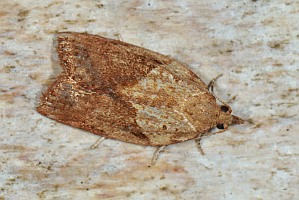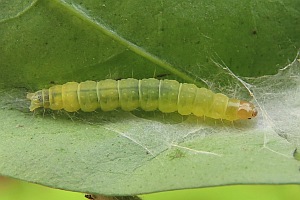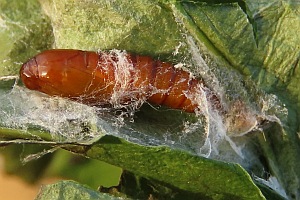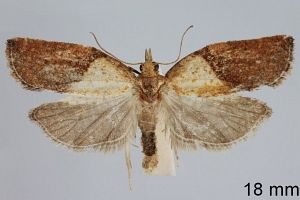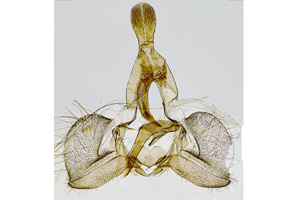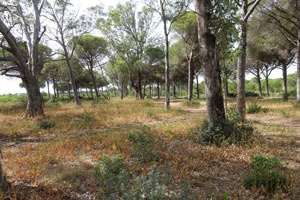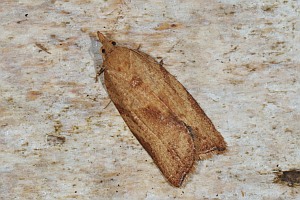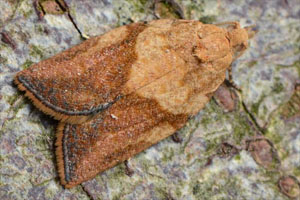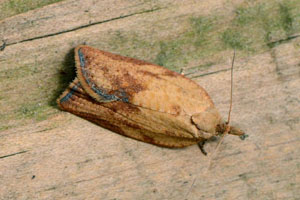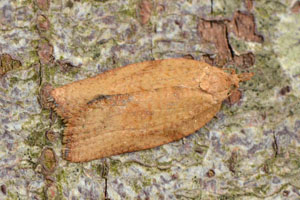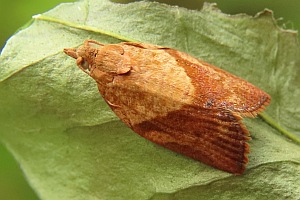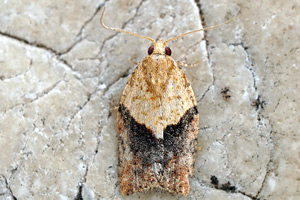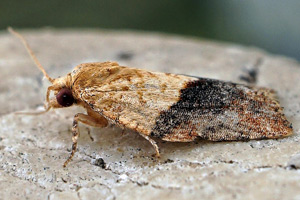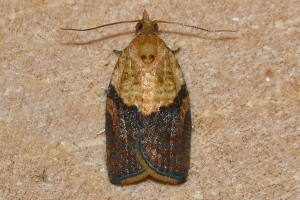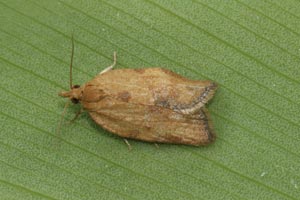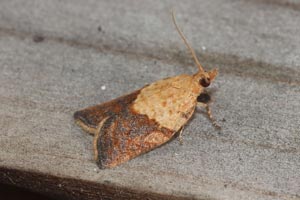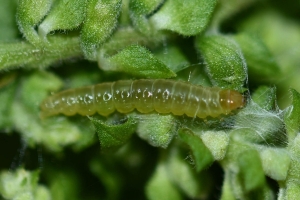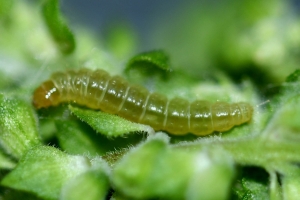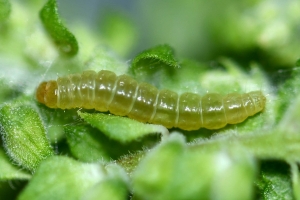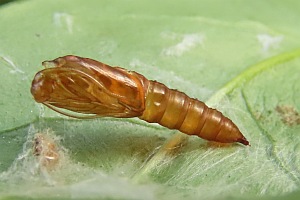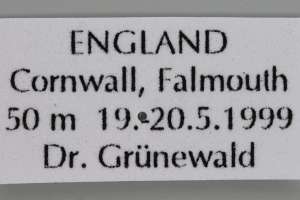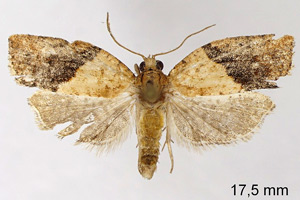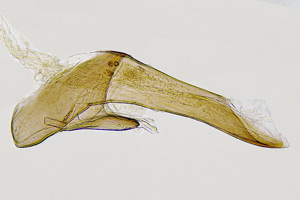

 +11Kontinente:EUNAOC
+11Kontinente:EUNAOC1. Lebendfotos
1.1. Falter
1.2. Raupe
1.3. Puppe
2. Diagnose
2.1. Männchen
2.2. Genitalien
2.2.1. Männchen
2.3. Erstbeschreibung
3. Biologie
3.1. Habitat
3.2. Nahrung der Raupe
- [Oleaceae:] Ligustrum vulgare (Gewöhnlicher Liguster) [England, siehe Bilder oben]
- [Oleaceae:] Olea europaea (Ölbaum)
- [Fabaceae:] Medicago sativa (Saat-Luzerne)
- [Fabaceae:] Medicago lupulina (Hopfen-Luzerne, Hopfenklee, Schneckenklee)
- [Fabaceae:] Melilotus albus (Weißer Steinklee)
- [Fabaceae:] Phaseolus vulgaris (Gartenbohne)
- [Fabaceae:] Pisum sativum (Erbse)
- [Fabaceae:] Vicia faba (Ackerbohne, Saubohne)
- [Fabaceae:] Vicia sp. (Wicke)
- [Fabaceae:] Wisteria sinensis (Chinesischer Blauregen)
- [Fabaceae:] Laburnum anagyroides (Goldregen)
- [Fabaceae:] Ulex europaeus (Stechginster)
- [Fabaceae:] Cytisus sp.
- [Fabaceae:] Genista sp.
- [Fabaceae:] Cassia sp.
- [Fabaceae:] Lupinus sp. (Lupine)
- [Fabaceae:] Lotus sp. (Hornklee)
- [Fabaceae:] Senna sp.
- [Fabaceae:] Trifolium sp. (Klee)
- [Fabaceae:] Hardenbergia violacea (Purpur-Korallenerbse)
- [Fabaceae:] Clianthus puniceus (Papageienschnabel)
- [Fabaceae:] Carmichaelia speciesa
- [Fabaceae:] Acacia sp. (Akazie)
- [Rosaceae:] Malus domestica (Kultur-Apfel)
- [Rosaceae:] Malus sp. (Apfel)
- [Rosaceae:] Prunus persica (Pfirsich)
- [Rosaceae:] Prunus dulcis (Mandel)
- [Rosaceae:] Prunus domestica (Pflaume)
- [Rosaceae:] Prunus avium (Süßkirsche)
- [Rosaceae:] Prunus armeniaca (Aprikose)
- [Rosaceae:] Prunus sp.
- [Rosaceae:] Pyrus communis (Garten-Birne)
- [Rosaceae:] Pyrus sp. (Birne)
- [Rosaceae:] Pyracantha angustifolia (Schmalblättriger Feuerdorn)
- [Rosaceae:] Crataegus sp. (Weißdorn)
- [Rosaceae:] Chaenomeles speciosa (Chinesische Zierquitte)
- [Rosaceae:] Cotoneaster sp. (Zwergmispel)
- [Rosaceae:] Cydonia sp. (Quitte)
- [Rosaceae:] Photinia glabra [= Crataegus glabra] (Japanische Glanzmispel)
- [Rosaceae:] Photinia x fraseri (Rotlaubige Glanzmispel)
- [Rosaceae:] Rhaphiolepis umbellata (Japanischer Traubenapfel)
- [Rosaceae:] Rosa sp. (Rose)
- [Rosaceae:] Rubus fruticosus (Brombeere)
- [Rosaceae:] Rubus idaeus (Himbeere)
- [Rosaceae:] Rubus parvus
- [Rosaceae:] Rubus sp.
- [Rosaceae:] Spiraea x arguta
- [Rosaceae:] Spiraea sp. (Spierstrauch)
- [Rosaceae:] Kerria japonica (Kerrie, Ranunkelstrauch, Japanisches Goldröschen)
- [Rosaceae:] Fragaria moschata (Moschus-Erdbeere, Zimt-Erdbeere)
- [Rosaceae:] Fragaria sp. (Erdbeere)
- [Rosaceae:] Duchesnea indica (Indische Scheinerdbeere)
- [Plantaginaceae:] Plantago sp. (Wegerich)
- [Plantaginaceae:] Penstemon sp. (Bartfaden)
- [Plantaginaceae:] Veronica sp. (Subgenus Hebe) (Neuseeländische Strauch-Veronika)
- [Grossulariaceae:] Ribes viburnifolium (Catalina-Johannisbeere)
- [Grossulariaceae:] Ribes sp.
- [Ericaceae:] Calluna vulgaris (Heidekraut)
- [Ericaceae:] Vaccinium sp.
- [Ericaceae:] Arctostaphylos sp. (Bärentraube)
- [Rhamnaceae:] Rhamnus sp. (Kreuzdorn)
- [Rhamnaceae:] Ceanothus sp. (Säckelblume)
- [Rutaceae:] Citrus x limon (Zitrone)
- [Rutaceae:] Boronia sp.
- [Rutaceae:] Crowea sp.
- [Vitaceae:] Parthenocissus vitacea [= Parthenocissus inserta] (Gewöhnliche Jungfernrebe, Rankender Mauerwein)
- [Vitaceae:] Vitis vinifera (Wein)
- [Sapindaceae:] Dodonaea viscosa
- [Celastraceae:] Euonymus sp. (Pfaffenhütchen)
- [Lamiaceae:] Salvia sp. (Salbei)
- [Lauraceae:] Laurus nobilis (Echter Lorbeer)
- [Hydrangeaceae:] Hydrangea sp. (Hortensie)
- [Melastomataceae:] Pleroma urvilleanum [= Tibouchina urvilleana] (Prinzessinnenstrauch)
- [Myricaceae:] Myrica californica
- [Myrtaceae:] Callistemon sp. (Zylinderputzer)
- [Onagraceae:] Fuchsia sp. (Fuchsie)
- [Pittosporaceae:] Pittosporum sp. (Klebsame)
- [Salicaceae:] Populus sp. (Pappel)
- [Asteraceae:] Achillea millefolium (Gewöhnliche Schafgarbe)
- [Alstromeriaceae:] Alstroemeria sp. (Inkalilie)
- [Proteaceae:] Leucadendron sp. (Silberbaum)
Die Art ist ein hochgradig polyphager Kräuterfresser. Wie gut abgesichert die einzelnen Artbestimmungen dabei sind, ist mir unklar. Angaben aus Europa scheinen noch weitgehend zu fehlen. Auf [Ukmoths (abgefragt 3. November 2020)] wird aber pauschal zusammengefasst: "A pest species in Australian orchards, it is one of the most catholic polyphages in Britain, and should be considered as a possibility when identifying larvae off any plant."
Und Gaona et al. (2020: 154) summieren unter dem Aspekt der Schädlichkeit dieser Art: "Es una especie polífaga, alimentándose de más de 120 géneros de plantas. Entre los árboles frutales destacan: Actinidia deliciosa Chev. (kiwi); Mangifera indica L. (mango); Persea americana Mill. (aguacate); Musa paradisiaca L. (plátano); Malus domestica L. (manzana); Pyrus sp (pera). También representantes de las familias Brassicaceae y Solanaceae, forman parte de su dieta (Venette et al., 2003; Espinosa & Hodges, 2009). Las orugas pueden causar daños a cultivos de árboles frutales de hoja caduca, cítricos y frutas como la uva (Geier & Briese, 1981). Al alimentarse de los brotes y las hojas, reducen el crecimiento de la planta, dejando el fruto inservible para su comercialización (Irvin, 2009)."
Brockerhoff et al. (2011) hatten alles zusammengezählt was sie irgendwie finden konnten - und sie kamen dabei auf 545 Wirtspflanzenarten aus 363 Gattungen und 121 Pflanzenfamilien. Sie vermerken dazu: "Based on our review, there are at least 545 plant species in 363 genera from 121 families that have been reported as hosts of light brown apple moth. Some plants were reported only once and need verification. Nevertheless, many host plant species and their wide phylogenetic range (from ferns to higher dicotyledons) indicates that light brown apple moth is one of the most polyphagous insects known. This information and our categorization of frequency of host use are valuable for incursion response and pest management activities."
Die obige Liste umfasst außer dem in Europa belegten Ligustrum vulgare diejenigen Pflanzenarten, die nach Brockerhoff et al. (2011) häufiger für Neuseeland und/oder Nordamerika erwähnt wurden. Im Einzelfall kann hier durchaus auch eine Fehlbestimmung Eingang gefunden haben, die dann häufig abgeschrieben wurde, doch insgesamt dürften die entsprechenden Arten doch gut belegt sein.
4. Weitere Informationen
4.1. Andere Kombinationen
- Tortrix postvittana Walker, 1863 [Originalkombination]
4.2. Faunistik
E. postvittana wurde von Sydney beschrieben, also von der Ostküste Australiens. Die Art wurde von Australien aus nach Neukaledonien, Neuseeland, Hawaii und bald auch England verschleppt, schließlich auch nach Kalifornien.
Emmerson & Hoare (2019: 60) meldeten die Art für Albany (Auckland, Neuseeland) als Adventivart und vermerkten: "Very common throughout the year."
I. Kimber teilt auf seiner Website “UKmoths” [998 Light Brown Apple Moth Epiphyas postvittana] mit, dass die ursprünglich australische Art wahrscheinlich in den 1930er Jahren nach Cornwall (England) eingeschleppt wurde. Auf [demon.co.uk/insects/WatchList Keith Edkins, last updated September 2015] ist zusammenfassend zur Situation in England zu lesen: "This species is spreading rapidly through the UK after first being recorded in Cornwall in the 1930's. It is now reaching almost pest proportions in some parts of the UK and can be seen in most months of the year in southern counties, the midlands and north-west, and has been reported from Scotland and Northern Ireland."
Nach dem Titel einer französischen Arbeit (Cosson 2009) scheint sich die Art auch dort auszubreiten.
Gaona et al. (2020) melden den Erstnachweis der Art für Spanien, und zwar von ganz im Süden des Landes (Vejer de la Frontera, Provinz Cádiz): Dort wurden fünfmal Falter in Lichtfallen registriert, die frühesten am 6. März 2020, die bisher letzten am 1. September 2020. Gaona et al. (2020) wagen auch eine Übersicht über das bisherige Auftreten der Art in Europa: "Gran Bretaña, Irlanda, Francia, Países Bajos (Carter, 1984), Suecia (Svensson, 2009) y Azores (Portugal) (Hummer et al., 2009) cuentan con la presencia de este Tortricidae."
Ganz besonders interessant ist für uns eine Thesis-Arbeit aus Neuseeland (HE 2010), denn darin werden anhand der Ansprüche des Falters an Wärme und Feuchtigkeit auch Vorhersagen über die Eignung bzw. Nichteignung verschiedener Erdteile gemacht. Zu Europa heißt es unter der Überschrift "2.3.3 Predicted potential distribution in European countries": "Southwestern Europe is relatively more suitable for E. postvittana establishment than north and east Europe (Figure 2.6). Most areas in UK are predicted suitable for the moth, as E. postvittana is currently widespread all over that country (Suckling & Brockerhoff 2010). Countries such as Portugal, France, Italy, and Greece are predicted under high risk of E. postvittana establishment with EI values up to 69. Heat and dry stress indices showed no general effects in Europe. Northwestern Europe appears not to be favorable for E. postvittana establishment because of high cold stress in that area (Appendix 7a, b & c). European countries such as Germany, the Netherlands, Belgium, France, Italy, United Kingdom, Ireland and Portugal might potentially be suitable for establishment of E. postvittana in a few locations where the EI values range from 50 to 69. The British Isles in which E. postvittana is currently distributed, was shown suitable for E. postvittana establishment with EI value around 2-54 and the lowest values are those in the northern area." Für Deutschland ist nach der gezeigten Karte (Fig. 2.6 Seite 35) mal wieder vor allem das Grenzgebiet zu Belgien und zu den Niederlanden prädestiniert.
(Autor: Erwin Rennwald)
4.3. Literatur
- Brockerhoff, E.G., Suckling, D.M., Ecroyd, C.E., Wagstaff, S.J., Raabe, M.C., Dowell, R.V. & C.H. Wearing (2011): Worldwide Host Plants of the Highly Polyphagous, Invasive Epiphyas postvittana (Lepidoptera: Tortricidae). — Journal of Economic Entomology, 104 (5): 1514-1524. [zum PDF-download auf researchgate.net]
- Cosson, A. (2009): Epiphyas postvittana, une espèce invasive venue d’Australie (Lep. Tortricidae). — Oreina 7: 4-5. [PDF auf oreina.org]
- Emmerson, A. & R. Hoare (2019): Lepidoptera from Redvale, Albany, north of Auckland, New Zealand, 2004-2016: an annotated list. — The Weta, 53: 43-70. [weta.ento.org.nz]
- Gaona, J.M., Grundy, D., Rodríguez, R., Button, K., Twiss, S. & S. Knapp (2020): Primer registro de Epiphyas postvittana (Walker, 1863) (Lepidoptera: Tortricidae) para España. — Boletín de la SAE, 30: 154-157.
- He, Shu-Qi (2010): Pest risk assessment of light brown apple moth, Epiphyas postvittana (Lepidoptera: Tortricidae) using climate models and fitness-related genetic Variation. - A thesis submitted in partial fulfillment of the requirements for the Degree of Master of Science. - XII + 129 S.; Lincoln University Digital Thesis, Christchurch, New Zealand. [PDF auf lincoln.ac.nz]
- Oliveira, L., Vieira, V., Soares, A. O., Borges, I., Arruda , P. & J. Tavares (2022): Abundance of Epiphyas postvittana (Walker, 1863) in forestry nurseries of São Miguel Island (Azores, Portugal) (Lepidoptera: Tortricidae). — SHILAP Revista de lepidopterología 50 (199): 425-433. [PDF auf shilap.org]
- Vieira, V., Oliveira, L., Onofre Soares, A., Borges, P. A. V. & I. Borges (2022): Diversity of Lepidoptera (Insecta) recorded in a forest nursery of Nordeste County on São Miguel Island (Azores). — Biodiversity Data Journal 10: 1-19. [Zum PDF auf bdj.pensoft.net]
- Erstbeschreibung: Walker, F. (1863): List of the Specimens of Lepidopterous Insects in the Collection of the British Museum 28: 287-561. London.












